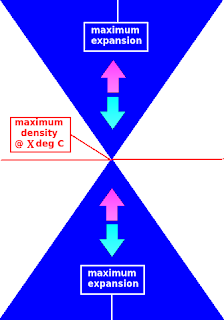 |
| Fig. 1 Is it Verifiable or Falsifiable? |
I. Background
There is so much disbelief and lack of analysis in the realm of discerning "thermal expansion" on the part of the Warming Commentariat and some oceanographers as well, that once again I must review one of the Dredd Blog assertions about it.
The issue I am focusing on today is my assertion over the years that thermal expansion does not take place in all cases where the seawater temperature increases.
In fact I have gone so far as to say that it depends on the temperature of the seawater at the time the temperature changes (ergo in some cases the increase of the seawater temperature will cause thermal contraction meaning the seawater will "shrink" which is to say decrease in volume and increase in density.
Water is one of the only things where this is the case, which means that the hypothesis seems to be a mythical rather than a scientific concept.
In fact this past week I have doubted myself to the point of writing a C++ program that points out that the hypothesis can be verified or falsified, which at least makes it a valid hypothesis (Falsifiability, Popper; Verifiability).
II. The Brass Tacks
As I indicated above "getting down to the brass tacks" in this case began with the writing of a C++ program.
The exercise was to show that if the temperature of seawater warms, the result in terms of volume increase or to the contrary volume decrease DEPENDS ON THE TEMPERATURE OF THE WATER AT THE TIME the temperature change takes place.
If the temperature is above the temperature of maximum density (see Fig. 1) then there will be thermal expansion, but to the contrary if the temperature is below the temperature of maximum density, there will be thermal contraction.
III. The Experimental Data
Today's appendix (APNDX TSCR 3) contains an HTML table and a graph which together show the results of the following process.
1) these initial variables are required:
--------------------------------
in situ variables
--------------------------------
SP = in situ salinity
T = in situ temperature (deg. C)
depth = in situ depth (meters)
lat = latitude
lon = longitude
2) with those in situ variables, use TEOS-10 software to calculate TEOS-10 variables:
--------------------------------3) by using the following TEOS-10 functionality:
TEOS-10 variables
--------------------------------
Z = geodesic height (negative)
P = pressure
SA = Absolute Salinity
CT = Conservative Temperature
TEC = thermal expansion coefficient
------------------------------------------
TEOS-10 methods/functions
------------------------------------------
(Z)
gsw_z_from_depth(depth);
(P)
gsw_p_from_z(Z, lat,0.0,0.0);
(SA)
gsw_sa_from_sp(SP, P, lon, lat);
(CT)
gsw_ct_from_t(SA, T, P);
(specific volume)
gsw_specvol(SA,CT,P);
(Density)
>gsw_rho(SA,CT,P);
(TEC)
gsw_alpha(SA, CT, P);
The appendix contains displays of the results which seem to confirm the hypothesis (APNDX TSCR 3).
If I pour water onto its forms (steam, liquid, ice), for instance ice, it will shrink in volume as it transitions to water.
Same with steam.
This is not an easy-to-grasp situation, so I will keep working on it until I find a better way to falsify it or verify it.
Helpful suggestions accepted.
The next post in this series is here, the previous post in this series is here.
No comments:
Post a Comment